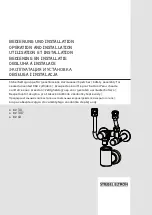
The first, vertical, section (equivalent to dimension X) is measured from
the top of the boiler casing. Cut the vertical section of the extension
duct to 167mm less than the measured distance. Do not remove the
socketed ends.
The minimum measured distance is 167mm.
Seal the air duct to the turret using silicone sealant.
12.14 Completion of the Installation
Check that the gas and water connections have been tightened. Refer to
Fig.3.
Fit the, optional, facia mounted clock or programmer. Refer to the
instructions sent with the control. Refer to Fig. 15.
Remove the facia bottom panel. Refer to Fig.12.
Connect the mains electricity supply to the appliance at terminal ST12. Refer
to Fig.8. The mains cable must be clamped.
Connect any room and/or frost thermostats, the electrical leads must pass
through the appropriate space in the control panel and be fixed with the
cable clamps provided. Refer to Fig.11.
Refit the facia bottom panel.
Test the gas supply pipework to the appliance for soundness as indicated in
BS6891.
If the appliance is not to be commissioned immediately, replace the cabinet
front panel. Check that the gas supply, the electrical supply and the water
connections are turned off.
If the appliance is to be filled and pressurised refer to Section 13,
Commissioning for a full description.
If the premises are to be left unoccupied during freezing conditions then
drain, or do not fill, the appliance and the system. For short periods
commission the appliance, Refer to Section 13, and leave the appliance
under the control of the built-in frost thermostat or remote frost thermostat
(if fitted) or leave operating continuously with the room thermostat set at 6°c.
Benchmark Water Treatment: For optimum performance after
installation, this boiler and its associated central heating
system should be flushed in accordance with the guidelines
given in BS7593:1992 - Treatment of water in domestic hot
water systems. Full instructions are supplied with proprietary
cleansers sold for this purpose. If an inhibitor is to be used
after flushing, it should be used in accordance with the
inhibitor manufacturers instructions.
Suitable flushing agents and inhibitors are available from Betz
Dearborn Tel: 0151 4209563 and Fernox Tel: 01799 550811.
Instructions for use are supplied with these products.
IMPORTANT: Any system cleanser must be flushed from the system
before an inhibitor is added.
13.1 SUMMARY
The appliance is dispatched with the controls set to provide a
maximum output for domestic hot water and central heating load of 24
kW (24/28CDi) or 27.5kW (
35CDi
II
).
The appliance automatically modulates to satisfy lower heat loads.
Domestic Hot Water Circuit
Confirm that the mains water supply has been flushed out at
installation. If not it will be necessary to disconnect the cold water inlet
pipe from the appliance and thoroughly flush.
Central Heating System
Confirm that the system has been fully flushed out at installation using
a flushing agent. Flush the system before starting to commission the
appliance and, at the end of the commissioning procedure, add a
suitable flushing agent and drain whilst hot. Immediately refill and re-
pressurise.
Gas Service. The complete system, including the meter, must be
inspected and tested for soundness and purged as indicated in BS
6891. In the event of a leak, or suspected leak, at the ‘O’ ring joint on
the main appliance manifold, connect a manometer to the test point
on the inlet of the multifunctional gas valve. A soundness test carried
out after turning off the appliance gas cock will test the section
between the gas cock and the gas valve, thus enabling the leak to be
traced to either a visible joint or to the ‘O’ ring.
13.2 APPLIANCE AND CENTRAL HEATING SYSTEM PREPARATION
Remove the cabinet front panel.
Check that the electrical supply and the gas service to the appliance are off.
Check that all the water connections throughout the system are tight.
Open the system valves at the appliance. Open all the radiator valves,
fill the system and vent each radiator in turn.
Remove the bottom panel to gain access to the filling loop assembly.
Refer to Section 15.3d The grey knob for the filling loop is packed in the
hardware pack and
13. Co
mmissioning
17
ISOLATE MAINS SUPPLY
BEFORE REMOVING COVER
GAS VALVE
PRESSURE SETTING
MODE SWITCH
TEST MIN.
TEST MAX.
NORMAL OPERATION
CENTRAL HEATING ADJUSTMENT
REFER TO INSTALLATION AND
SERVICING INSTRUCTIONS
+
–
ISOLATE MAINS SUPPLY
BEFORE REMOVING COVER
GAS VALVE
PRESSURE SETTING
MODE SWITCH
TEST MIN.
TEST MAX.
NORMAL OPERATION
CENTRAL HEATING ADJUSTMENT
REFER TO INSTALLATION AND
SERVICING INSTRUCTIONS
+
–
Fig. 26. Appliance Casing, Facia Controls and
Location of Equipment.
Inner casing cover
fixing screws (4)
Burner
observation
hole
Circulating
pump
Air
pressure
switch
Water to
water heat
exchanger
Gas
valve
Pressure
relief
valve
Facia shown in the service
position
Facia panel fixing
screws (2)
Front
of
facia
panel
Bottom facia fixing
screws (3)
Gas
valve
Facia
fixing
screw
Rear of facia shown in
service position
Plastic
water cover
over controls
and gas
mode
switch
28CDi and 35CDi
II
ONLY (See Section 16.4.11)
Detail of gas
valve
mode
switch
Screwdriver
slot
adjustment
Summary of Contents for 24CDi
Page 28: ...28 109 ...
















































